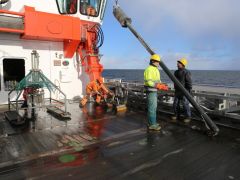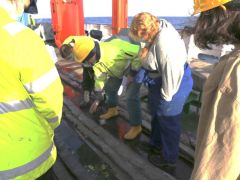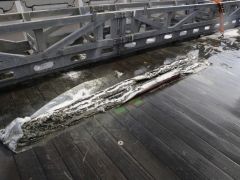
Home run for the RV Maria S. Merian:
Research vessel sets off towards the Baltic Sea ice
for the "Deep Baltic" mission
01.-04.03.2021 – In search of the “Little Ice Age”
The “great coring” has begun. Today and on the following days, a total of 13 tube cores, each 6 meters long, will be pulled, cut open on deck and documented. Matthias Moros explains the history of the Baltic Sea since the last glacial to all Baltic Sea newcomers on the basis of the sediments. We already got to know the Baltic Ice Lake as the first post-glacial stage about 12,000 to 10,000 years ago in the form of clayey pink-grey deposits. Next comes the relatively short Yoldia phase around 10,000 to 9,700 years before today. It is preserved in form of deposits of a water body of oceanic character, which was created when in central Sweden a passage for North Sea water had opened, through which salt water now flowed into the Baltic Sea. Above it follow the deposits of a freshwater lake - they represent the 9,500 to 8,000 year old Ancylus stage. The mid-Swedish passage had closed again due to the uplift of the Scandinavian mainland after the disintegration of the ice sheet, so that only freshwater could enter the Baltic Sea basin. Finally, around 7,000 B.P., parallel to the time of the Holocene thermal maximum, there was a drastic rise in sea level, which again created new, albeit narrow, connections to the North Sea in the form of the Belts and Sounds. The thus formed Littorina Sea was already very similar to today's Baltic Sea - just also a brackish water sea with strongly impeded water exchange.
The Littorina layers interest us most in "Deep Baltic". They should contain deposits of different warmer and colder climatic periods - like the Medieval Warm Period or the "Little Ice Age".
We want to know in which positions in the deep basins of the Baltic Sea the layers of the Little Ice Age are still preserved and where they are missing, because according to the hypothesis put forward by Matthias Moros and Thomas Neumann, winter deep water formation may have taken place also beyond the Bottenwiek during the Little Ice Age, which may then have triggered deep currents causing the erosion of earlier deposits.
13 cores later, Matthias Moros is satisfied. He believes he has found what he was looking for. He can't really know for sure until the sediments in question are dated. But the material is promising.
When the last cores are deposited on deck, they already get a little snow cover. We are at about 60° N, which is nearly the same altitude as St. Petersburg or Uppsala ... and it is getting icy.
Text and photos by Barbara Hentzsch (IOW) | click photos to enlarge
| Expedition: | MSM99 |
| Mission: | Deep Baltic |
| Start: | 25.02.2021 - Emden |
| Destination: | 23.03.2021 - Emden |
Maria S. Merian: current position


